by Jarrod Zenjiro Suda
As the sun cracks past the horizon, I awake in the ferry’s passenger quarters. Wiping the sleep from my eyes, I begin to pack quietly, making sure not to wake up others in the dark room. My excitement stirs as this red-eye boat ride¹ from Osaka Bay to Shikoku Island comes to a close.
An archipelago of six islands connected by 55 bridges, known as the Shimanami Kaido Expressway, runs from the northern tip of Shikoku Island to the southern edge of Honshu – the Japanese “mainland.” I am hoping to ride to Honshu, which is waiting for me at the other end of this 70-kilometer landscape, by bicycle before the end of the day.
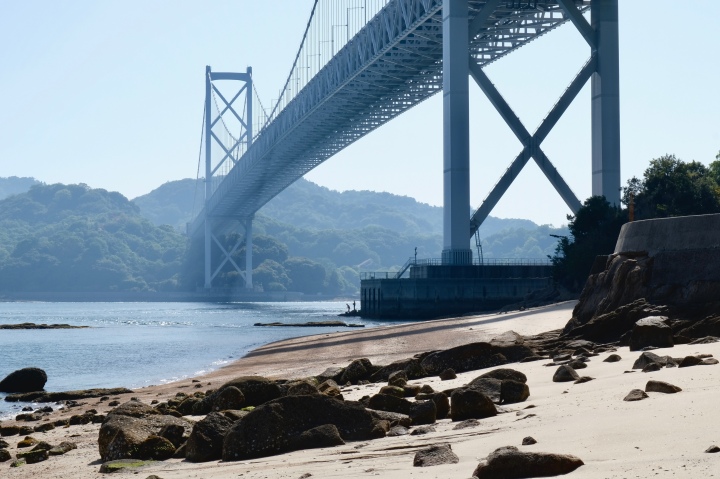
The construction of the Shimanami Kaido in 1999 unified Shikoku with the rest of the country’s highway system. However, Shikoku’s geographic detachment from mainland Japan still leaves a lasting mark on the island’s inhabitants. The fishermen – especially those who live along the isolate southern coastline – are often considered to be persevering and industrious.
To prepare for my trip, I asked a Japanese friend, “Do people from Shikoku really have that hard-working personality?”
“Well, the fishermen make a lot of money,” he said. Raising an imaginary glass of sake, he added, “And they drink a lot!”
I asked a woman from Shikoku about her hometown’s character.
On cue, she proudly replied, “We Tokushima women are more straightforward than Tokushima men!”
These generalizations by prefecture are actually quite common across Japan. Debates over the quality of okonomiyaki (a Japanese savory pancake) from Hiroshima and Osaka make for playful bar conversation. Dialects spoken by the elderly of Aomori and Okinawa are almost incomprehensible to the young high schoolers of Tokyo. These regional quirks foster a sense of communal identity, and learning about them makes me curious to see for myself just what these places are like.
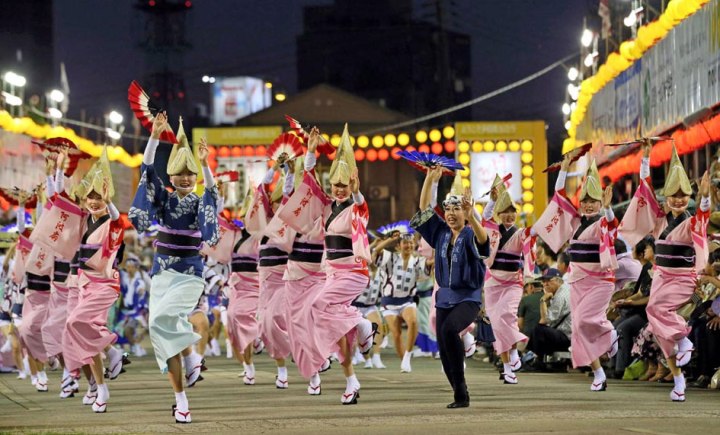
The women of Tokushima Prefecture, famous for the flashy Awa Dance Festival in August, have been described to be strong-willed and lively.²
I step off the ferry and onto an industrial port town of 170,000 people. The bright billboards, nightclubs, and two-story freeways of Osaka have vanished. I find myself surrounded by rows of rice paddies lining up and down the rugged, untouched coastline.
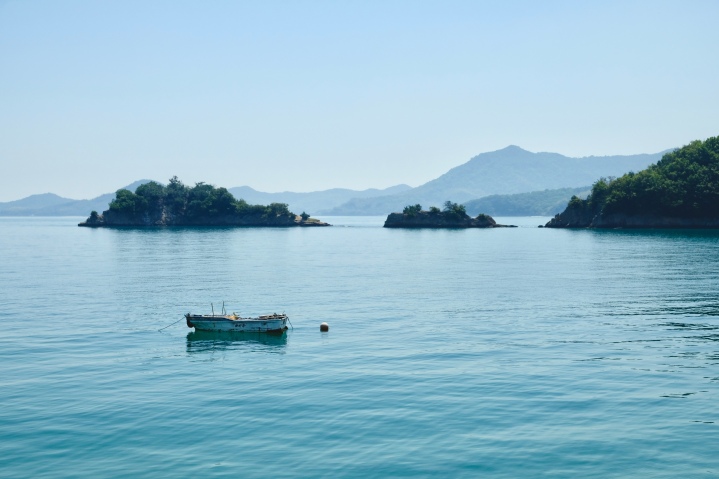
I rent a bicycle at the nearby train station³ and promise the shop manager that I’d drop it off at the other end of the Shimanami Kaido. My journey begins across Kurushima Kaikyo Bridge. The 215-foot drop down to deep blue water is utterly terrifying and magnificent. A massive shipping vessel swims below me. It weaves its way past the sleepy coastal villages of old thatched roof houses off in the distance. Modernity briefly visits a land trapped in time.
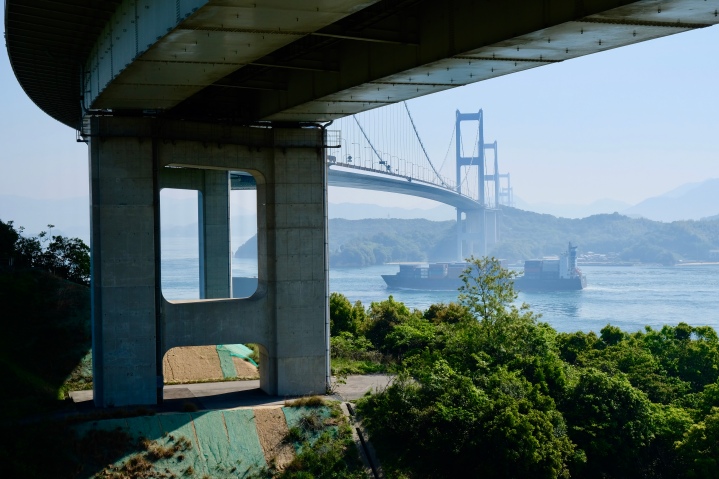
The Kurushima Kaikyo Bridge connects Shikoku Island to Oshima, the first of six islands that stretch through the Seto Inland Sea. The Tatara Bridge, which I cross later in the trip, is the fourth longest cable bridge in the world. The Shimanami Kaido is a true feat of civil engineering.
Throughout my ride along the coast, I pass by little shrines perched on barely-above-water islets. Men sitting in wooden fishing boats throw fishnets out into the gleaming water. During this island-hopping journey, a pagoda peeking out from the top of a small hill catches my eye. I decide to stop the bike-riding and the podcast-listening for a moment to go on a quick hike. I set my bicycle aside at the base of the temple and ascend the stone steps. Fresh laundry hangs on the side of worn-down houses. Cat eyes peer out from behind their hideouts to catch a glimpse of a stranger.
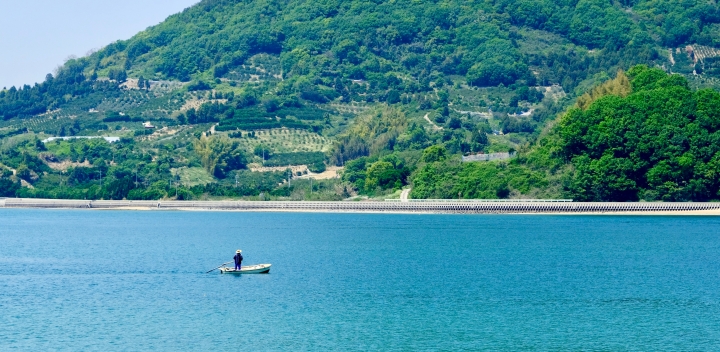
Walking the grounds in solitude, I feel alone on this archipelago. I stand above the old nameless temple and listen to the piercing cries of the cicada as they usher in the summer heat. Visible past the tree line, shipping vessels continue to navigate the waters.
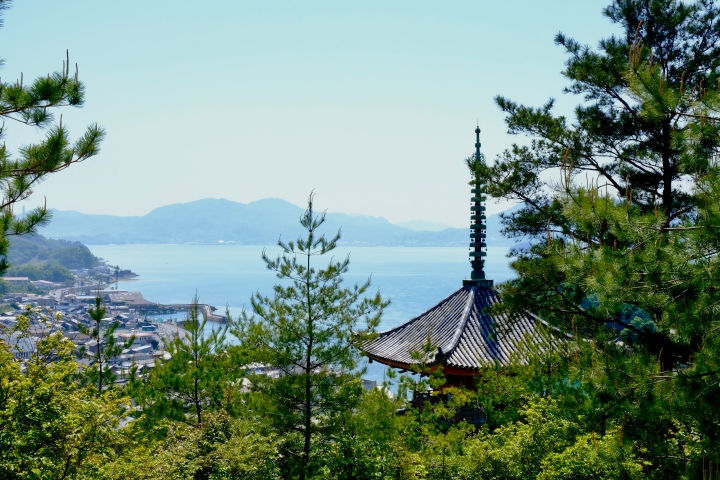
I return to my unlocked bicycle, which leans on the stone wall just as I had left it. Once I grip the handles, the latter half of my journey begins. A pain in my left hip grows – I am not at all used to the business of long-distance biking. I’ll be walking off this pain for the next two weeks. Regardless, I push on through to the end.
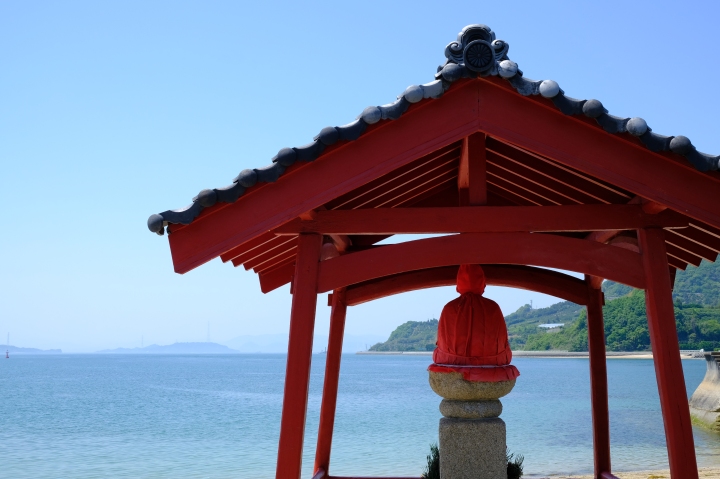
Japanese people often erect these stone statues and dress them in red bibs to honor Jizō, a Buddhist guardian of children and travelers. It is said that he guides the souls of children (who die before their parents) through limbo and to the afterlife.⁴
Before the sun touches the horizon again, the Shimanami Kaido leads me to Honshu. As I move past some traffic on the final bridge, the busy town of Onomichi opens up to greet me. Riding into the city center, I stumble upon a local weekend festival. The sound of taiko drums and koto strings fill the air. With a smile, I glance behind my shoulder to the quiet islands and bridges of the Shimanami Kaido.

This sweeping view of Onomichi City, Hiroshima can be seen from Senko-ji Temple, which was founded an astonishing 1,212 years ago.
1 Orange Ferry Company. https://www.orange-ferry.co.jp/.
2 Awa Odori in Tokushima photo. http://www.goldenjipangu.com/
3 Imabari Port Rent-a-Cycle Terminal. http://www.sunrise-itoyama.jp/
4 A guide to Jizo, guardian of travelers and the weak. https://www.japantimes.co.jp/
